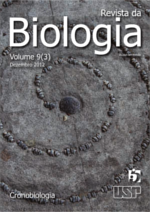The photic synchronization in nature: an investigation
DOI:
https://doi.org/10.7594/revbio.09.03.02Keywords:
Circadian rhythms, entrainment, light-dark cycle, light-samplingAbstract
Daily rhythms are observed in the majority of organisms, following day/night variations in their environment. Some of those rhythms are endogenously generated by oscillators which synchronize to environmental cycles, by means of entrainment. The daily light/dark cycle, recognized as an important synchronizing agent for various species, is frequently studied by protocols with alternating phases of 12 hours of light and 12 hours of darkness, which is not the real condition experienced in nature. For some animals, the dynamics of out-of-den activity and the sensitivity of photoreceptive pathways might modify the exposure to the light/dark cycle. Despite its importance, synchronization by light/ dark cycles cannot fully predict the activity pattern in the field, due to the effect of other environmental factors on the final activity/rest rhythmDownloads
Downloads
Published
2018-04-23
Issue
Section
Revisão
License
We ensure that our journal does not retain any copyright and that these are exclusive of the author(s) of the text. In that sense, we intend to break any restrictions to the published material and to achieve more intensely our goal of communicating science.
How to Cite
Flôres, D. E. de F. L. (2018). The photic synchronization in nature: an investigation. Revista Da Biologia, 9(3), 7-12. https://doi.org/10.7594/revbio.09.03.02






